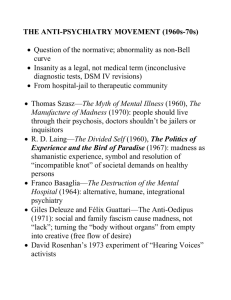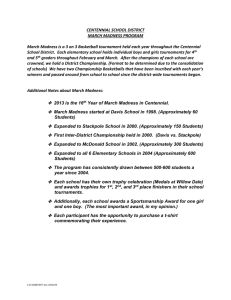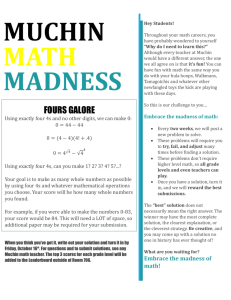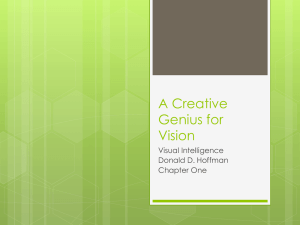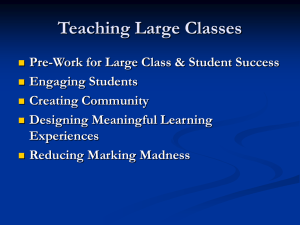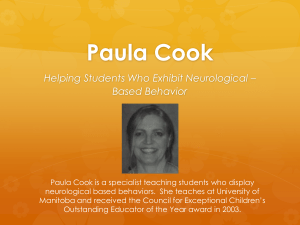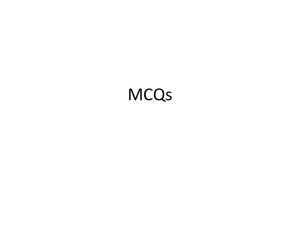Genius of Madness?
advertisement
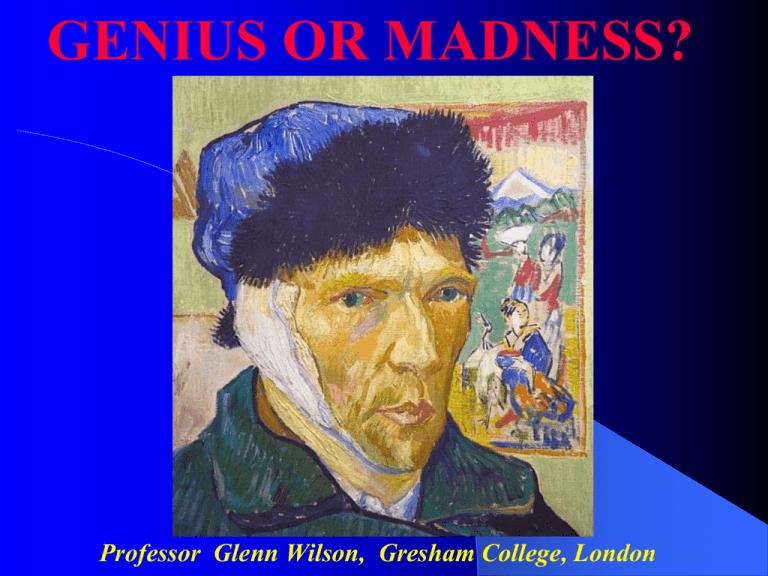
GENIUS OR MADNESS? Professor Glenn Wilson, Gresham College, London WISDOM OF THE POETS Great wits are sure to madness near allied And thin partitions do their bounds divide. (John Dryden, 1681) There is no great genius without a tincture of madness. (Seneca, 1st Century A.D.) ISAAC NEWTON Newton, one of the greatest scientists ever, introduced the concept of gravity and made major contributions to mechanics, optics & mathematics. Was intensely suspicious and distrustful. In later life dabbled in alchemy and sought hidden messages in the Bible. Suffered mercury poisoning? (Keynes, 2008) NIKOLA TESLA Rivalled Edison as an inventor, obtaining around 300 patents on radio and electrical technology. Pioneer of AC current and hydroelectric power. Spoke 8 languages and had a photographic memory. Claimed to be in communication with other planets and to have invented “death rays”. Various bizarre OCD symptoms. Celibate & reclusive. Slept for two hours/night. A BEAUTIFUL MIND John Nash - Nobel prize winning mathematician. Developed game theory as applied to social sciences. Experienced paranoid delusions. Hospitalised involuntarily & had to feign sanity to get discharged. I wouldn’t have had such good scientific ideas if I had thought more normally. GALILEO Whether one is recognised as a genius or seen as crazy depends partly on cultural context. To the Counter-Reformation Church, Galileo was dangerously heretical because his observations supported a heliocentric theory of the planets. In other times and places Picasso and Einstein might have been committed to an insane asylum rather than revered for their originality. Galileo faced a Vatican Inquisition in 1633. His ideas were declared “foolish and absurd” and he was sentenced to house arrest for life. The ban on his writings remained until 1835. He was vindicated by Pope John Paul II in 1992 and an apology was issued in 2000. BEHAVIOUR GENETICS Evidence for a genius-madness link comes from fact that close relatives of creative people have higher rates of schizophrenia, and vice versa (psychotics have more creative relatives). (Simonton, 2005) I have been surprised at finding how often insanity or idiocy has appeared among the near relatives of exceptionally able people (Francis Galton, Hereditary Genius, 1892) Einstein’s schizophrenic son (Eduard) TROUBLED AUTHORS Mental disorder is more common in close relatives of creative people than in creatives themselves. Actual illness usually impedes creative success. Exception is writers, who themselves have high rates of many disorders, including schizophrenia, mood disorders, anxiety, alcoholism, drug abuse and suicide. (Kyaga et al, 2012). Virginia Woolf suffered severe depressive episodes, finally drowning herself in the River Ouse. “CRADLES OF EMINENCE” Childhood trauma and orphan status are more common in high achievers (Goetzel et al, 2004). Such experiences may be motivating and inspirational, while also inducing mental illness. But wealth is more frequent than poverty in families of famous and ill-treatment may be genetically linked. Charles Dickens’ father was in debtors’ prison so he left school early to work in a factory (c.f., themes of child maltreatment and social reform). BIZARRE & GRANDIOSE Certain traits and thought processes are shared by genius and madman. Ideas are novel, unconventional and grandiose. Usually workaholic, ambitious, narcissistic & selfpromoting. Various genes and neurotransmitters implicated: including testosterone, a growth factor called neuregulin (NRG1), and genes modulating dopamine in the brain (DARPP-32). PERSONALITY & CREATIVITY Genius goes with high IQ & Psychoticism (P): includes novelty-seeking, risk-taking, impulsiveness, nonconformity, self-confidence & work-addiction. Associated with high dopamine & testosterone (Eysenck, 1995). Possessing some indicators of schizotypy promotes creative achievement but not full-blown schizophrenia. (Kuszewki, 2009) DOPAMINE CIRCUITS Commence in limbic mid-brain and project to motivational areas of the frontal cortex. Systems concerned with reward, approach and positive mood. Implicated in novelty-seeking, impulsiveness, psychoticism, addiction. LOOSE ASSOCIATIONS Schizophrenic thinking is characterised by loose associations – “thinking outside the box”. e.g., Unusual responses on Word Association test; Dali’s surrealistic designs. Flashcards are used in “brainstorming” sessions to force fresh ideas. Great artists/scientists usually seen as “rebels” in their field. OVERINCLUSIVE THINKING Schizophrenics and “manic” persons often set boundaries of relevance too broadly. c.f., great thinkers who come up with “grand unifications”. To most people there is no connection between an apple falling off a tree and the motion of planets. Newton (1665) was able to connect them with concept of gravity. Newton’s apple tree at Woolsthorpe Manor, Lincs APOPHENIA Human tendency to see meaningful patterns where they do not exist. Underlies superstition, belief in paranormal, seeing ghosts, UFOs, miracles, conspiracies, hearing “voices” etc. Apophenia is exaggerated in schizotypal persons and increased by dopamine. May contribute to both creativity and madness. Face on Mars (captured by Viking 1, 1976). BIPOLAR MOOD DISORDER Off the wall comedian Paul Merton among many creative performers treated for mood disorder. Merton also displayed certain psychotic symptoms such as hearing voices and believing he was targeted by Freemasons. His freestyle comedy style seems to benefit from “loose associations” (c.f., Spike Milligan). PSYCHOSIS AND MOOD DISORDER Genetic analysis shows overlap between schizophrenia and bipolar mood disorder. Some genes unique to each condition; others (including NRG1) are common to both. (Schematic diagram from Owen et al, 2007) THE AUTISTIC SPECTRUM Asperger’s Syndrome (deficient social communication) has been posthumously assigned to many geniuses, including Michelangelo, Mozart, Newton, Wittgenstein, Marie Curie and Einstein. Another way of saying they were slightly odd or schizotypal? Michelangelo was melancholic, abstemious, work-obsessed, solitary and lacking social skills. THE SAVANT PHENOMENON Savants are autistic individuals with exceptional skills, usually in musical, mathematical or memory skills. Usually too narrow and low in general IQ to be great achievers. Prenatal testosterone may be involved. The film Rain Man concerns an autistic man whose memory for cards was exploited by his brother in Las Vegas casinos. Character based on Kim Peek, a savant who probably had a chromosome disorder (Opitz-Kaveggia Syndrome). ARTISTIC MADNESS? Louis Wain was a trained artist, hospitalised for schizophrenia in 1924. His trademark cats began as funny and whimsical (to entertain ailing wife); became progressively abstract and kaleidoscopic (even scary). May actually have suffered from Asperger’s or Toxoplasmosis (a parasite that can be caught from cats). CREATIVES APPEAR SEMI-PSYCHOTIC MMPI profiles of creative artists are on a continuum towards psychosis (similar profiles, but less extreme). (Simonton, 2005) Survival of genes for madness down to association with creativity? Helps to be slightly mad. CREATIVITY AS COURTSHIP Art functions as a mating display (c.f. the bower bird). Successful male artists have more sexual partners than unsuccessful ones. (No such connection for female artists). Male output for art, books, scientific discoveries is 10x M/F. (Clegg et al, 2011) INSIGHT AND CONTROL Lucia Joyce (daughter of novelist James Joyce) showed early talent as a modern dancer but became aggressive and self-destructive and was eventually committed to an asylum. Joyce doubted she could be schizophrenic because her thought patterns were similar to his own. Jung (who was treating her) said father and daughter were like two people who had arrived at the bottom of the river: “James had dived there, whereas Lucia had fallen in”. CONTACT WITH REALITY Prime marker of sanity. Salvador Dali was a talented painter whose surrealism seemed inspired by madness. However, he retained self-insight: There is one difference between a madman and me. The madman thinks he is sane, whereas I know that I am mad. Metamorphosis of Narcissus, 1937
